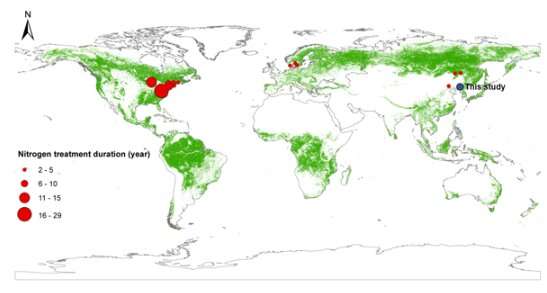Nitrogen deposition promotes tree growth and drives photosynthate allocation into wood in temperate and boreal forests

Human activities have greatly increased reactive nitrogen (N) emissions to the atmosphere, resulting in an increasing global atmospheric nitrogen deposition. Existing stimulated nitrogen deposition experiments are carried out mostly in forests with low background nitrogen deposition, whose treatment durations are often short. In China, nitrogen deposition levels have remained steady in the last ten years at a relatively high level. Our understanding of how tree growth responds to long-term nitrogen addition is limited.
Photosynthetic carbohydrates allocation among different tree organs is an important factor determining forest carbon (C) sink capacity. Nitrogen deposition may affect the allocation of photosynthates, and thus affect forest carbon sink capacity.
A research group led by Prof. Fang Yunting from the Institute of Applied Ecology of the Chinese Academy of Sciences conducted stimulated nitrogen deposition experiments in the larch forest and the mixed forest in the Qingyuan Forest, National Observation and Research Station. They monitored the responses of tree growth and litterfall production during 2014–2021 to detect nitrogen effects on tree growth and carbon allocation.
They also did meta-analysis on tree growth and carbon allocation data from other stimulated nitrogen deposition experiments in temperate and boreal forests worldwide to examine if there exist general effects of nitrogen deposition.
According to the researchers, eight years of simulated nitrogen deposition (50 kg N ha-1 yr-1) increased total biomass increment by 24% in both the larch and the mixed forests. The C-N response of total biomass was 11 and 10 kg carbon per kg nitrogen in the two forests, respectively.
In addition, nitrogen additions increased total litterfall production (9%) and foliage litterfall production (14%) in the mixed forest, and the positive effect decreased with treatment time. Nitrogen additions increased the ratio of woody biomass increment to foliage litterfall production (by 34% in the larch forest and 8% in the mixed forest) in both forests, indicating stronger promoting effect of nitrogen on woody biomass increment than on foliage litterfall production.
By integrating tree growth data from nitrogen addition experiments in other temperate and boreal forests worldwide, they found the similar pattern as in Qingyuan forests: simulated nitrogen deposition increased woody biomass increment and foliage litterfall production by 24% and 9% on average.
These results imply that nitrogen deposition promotes tree growth and may shift tree aboveground carbon allocation towards woody tissues over foliage in temperate and boreal forests around the world, which is conducive to enhancing forest stable carbon sink under the context of climate change such as global warming.
This study, titled "Effects of nitrogen deposition on carbon allocation between wood and leaves in temperate forests," was published in Plants, People, Planet.
More information: Meixia Gao et al, Effects of nitrogen deposition on carbon allocation between wood and leaves in temperate forests, Plants, People, Planet (2022). DOI: 10.1002/ppp3.10341
Provided by Chinese Academy of Sciences





















